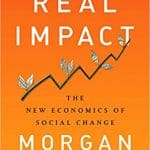Outside the Echo Chamber: How Silence is Sabotaging Impact Investing
As impact investing surpasses its 10-year anniversary, the industry has reached an inflection point. As with any movement that quickly gains traction and attracts followers, it’s seeing outsiders and newcomers jumping onto the impact bandwagon to profit from the trendline.
To take one prominent example, impact investors rejoiced earlier this year when Larry Fink, founder and CEO of BlackRock, issued an open letter to CEOs asserting that all companies around the world, private and public, should “serve a social purpose.” And other recent blue chip entrants to impact investing, like Goldman Sachs and TPG, have been similarly vocal about the steps they’ve taken to build out their impact investing business. These prominent voices have no doubt increased awareness and contributed to mainstreaming the impact investing movement. But these investors alone aren’t going to take the sector to the next level. And it’s worth asking why it took BlackRock’s declaration to start bringing impact investing the attention it deserves. What can the impact investing community do to ensure that the entry of these larger players doesn’t compromise the movement’s mission?
Stepping Outside the Echo Chamber
In order to sustain momentum and innovation in the industry, it’s essential that these bigger voices don’t outweigh or eventually eclipse the myriad of smaller impact investing players, including individuals, funds, nonprofits, foundations, financial advisors and technology startups. These stakeholders have not only been “talking the talk” of impact investing – they’ve been applying their time, money and expertise to put it into action. They’ve been building products, launching funds and introducing new marketplaces and methods of impact measurement. They’ve been educating wealth managers and financial advisors, and hosting workshops, conferences and webinars. And many of them have been championing the practice since long before the term “impact investing” was even coined.
Why does the work being done by these passionate individuals, organizations and funds tend to go largely unnoticed? It is often because they struggle to reach beyond the tight-knit circle of like-minded individuals that attend the same conferences, read the same industry news and operate in the same Twittersphere. For impact investing to truly move forward, the small and mid-scale impact community must step outside its echo chamber. It must shout to outside audiences about the fantastic work it has been doing, and bring the conversation to the public forum. The result: more brand equity, more recognition – and ultimately, more capital to change the world.
Silence Is Not Golden
That may sound like a lofty goal, but it all starts by communicating effectively about the organization, its work and its goals, both internally and externally. Setting unified messaging and crafting a strong, smart communications strategy is essential for firms that have the significant task of educating the world about impact investing – it’s not just a “nice to have.” That task may seem daunting for impact organizations, many of which operate under tight budgetary and even tighter staffing constraints. But taking a communications strategy piece-by-piece and teaming up with the right, like-minded partners can make it easier than one might think. Organizations in the impact investing space are more often than not made up of humble, altruistically-minded individuals who may shirk from having their names and work in the spotlight. But for impact investing to become the “new normal” in investment, it’s precisely these individuals that must be vocal and tell their stories, to educate the world on what might be the single most powerful capital movement of our time.
In the digital world, an organization can stand out from the crowd by promoting authentic thought leadership to a wide audience via tactics like sharp and interesting social media content, blogs, op-eds and proprietary research. Traditional media outlets like the Wall Street Journal, the New York Times and CNBC remain an effective method to communicate one’s message to stakeholders, particularly when looking to bridge the awareness gap from impact-minded individuals within the echo chamber to mainstream business and finance media. In a sign of impact’s growing resonance, many press institutions now have dedicated reporters covering the impact investing beat, or reporters that have developed an interest in impact and are keen to build up their book of sources. You might assume that these national business and finance reporters are mainly focused on speaking with representatives from impact-focused funds at the blue chip firms. But in fact, they’re just as – if not more – interested in speaking with practitioners who have been building the movement from day one.
Over the last year, the impact investing industry has grown to an estimated $228 billion in assets under management (according to the Global Impact Investing Network’s Annual Impact Investor Survey 2018). Though that number might sound quite large to the average person, it’s not even a fraction of what’s needed to make real-world change. To propel the movement forward and to ensure that it’s not misunderstood, impact firms of all sizes must establish communications strategies that are just as impactful as their investments. This is a key part of ensuring that impact investing reaches its true potential, and isn’t looked back on as just another investing fad.
Bar Cudkevich is an Associate Vice President at Aspectus Group.
To schedule a meeting with Bar at SOCAP 2018 in San Francisco October 23-26, shoot her an email at bar.cudkevich@aspectusgroup.com.
Image courtesy of iannis karydis.
- Categories
- Investing



